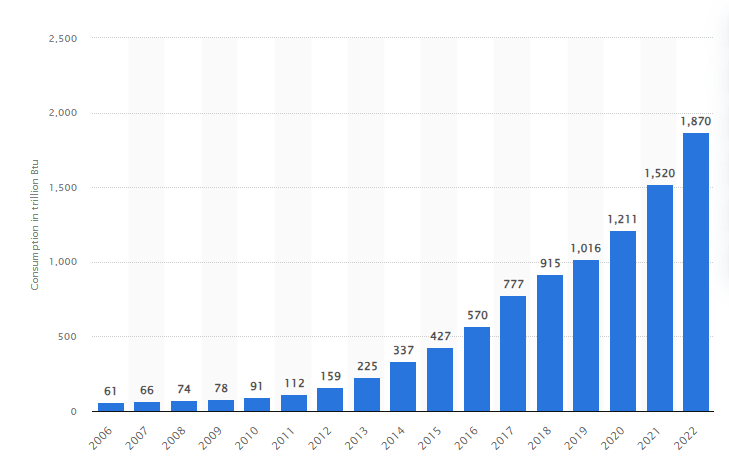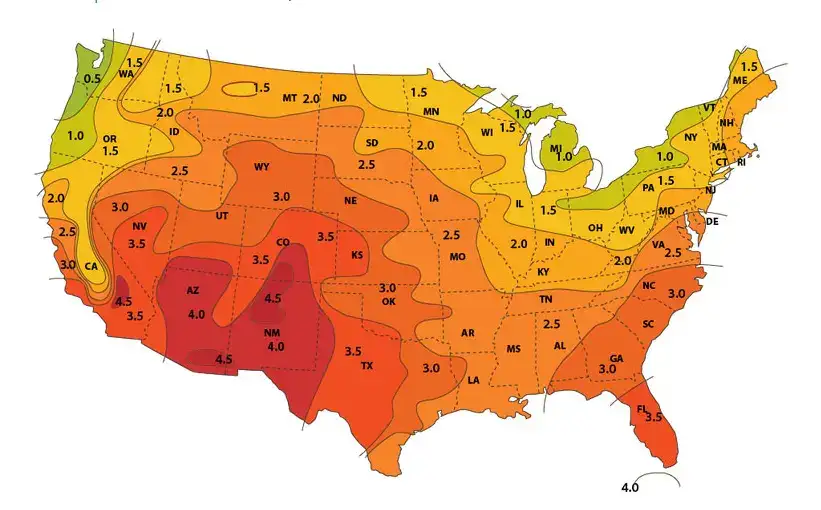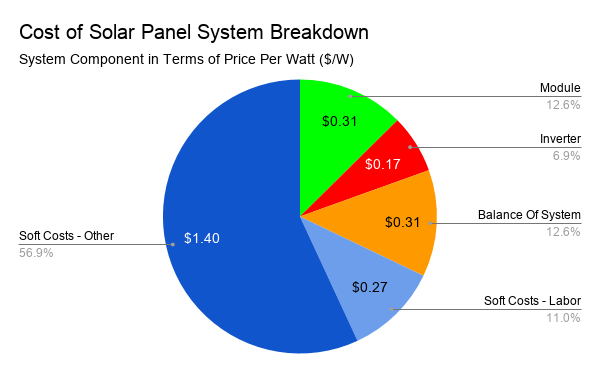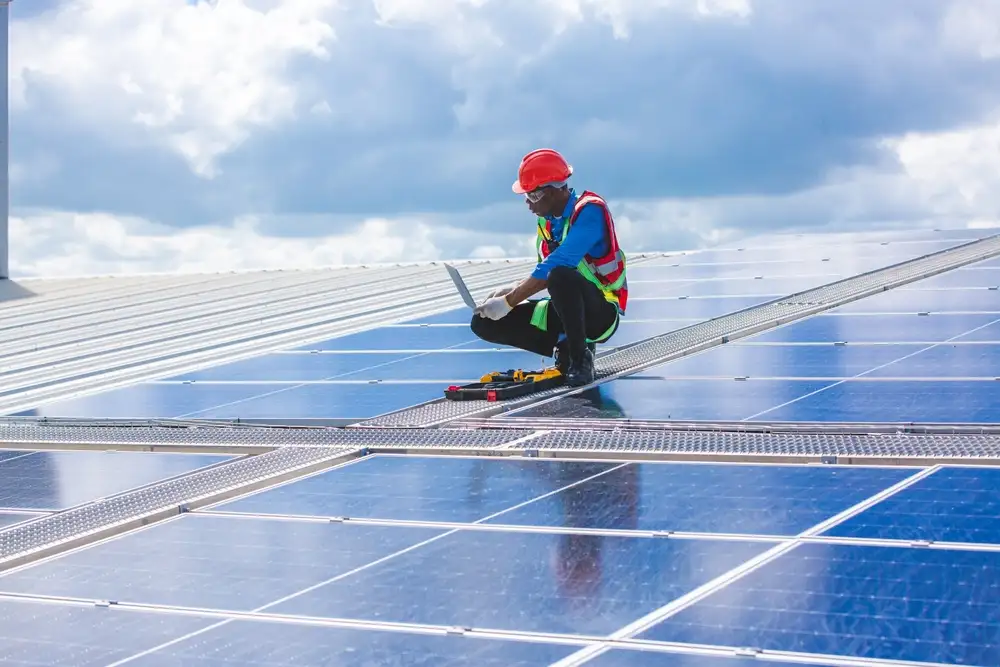California is an ideal place for solar panel system installation. Often referred to as the Golden State, it offers around 300 sunny days per year, contrasting with a national average of 210. According to Project Sunproof, 91% of properties located in California are fit for solar panel installation. Unsurprisingly, the state has more than 770 functioning solar plants with an installed capacity of 14,000 megawatts.
Despite initial solar panel costs, homeowners who adopt solar technology can benefit significantly from reduced electricity bills and saving up on utilities. This blog post comprehensively reviews solar panel installation costs in California, the benefits of transitioning to solar power, and practical tips on equipping your California residence with solar panel arrays.
Average Cost of Solar Panels
It’s safe to say that with a continuous increase in utility electricity rates, home solar panel systems have more cost-saving potential than ever before. Combined with a drastic decline in solar panel cost, it led to the popularity and widespread adoption of solar energy among US citizens. The country witnessed its highest solar thermal and photovoltaic energy consumption to date in 2022, exceeding 1.8 quadrillion British thermal units:

Source: Statista
Though many homeowners are open to the idea of solar panel installation, they may feel put off by the cost of solar panels. So, how much does solar cost by type in 2024?
| Monocrystalline solar panels | The cost of solar panels for the most recent models of top monocrystalline panels usually varies between $1 and $1.50 per watt. Suppose you install a single 400-watt solar panel. You pay between $400 and $600, depending on your purchase. |
| Polycrystalline panels | Polycrystalline panels, which are less efficient, cost around $0.75 per watt. It means you pay $300 for a 400-watt solar panel. |
Another factor influencing solar panel cost is the way you purchase it. You can expect to reduce expenses if you go with a full-service installer. However, choosing a retail store to buy a solar panel system individually will cost you more.
Solar panel types can make up around 20% of the total cost of solar panels. In the long run, going with cheaper but less efficient solar panel equipment won’t help you effectively decrease the overall cost of installing solar panels.
Why Should You Adopt Residential Solar in California?

If you are still on the fence regarding solar installation due to the cost of solar panels, here is the list of benefits the California solar panel system can bring.
Solar Energy Cost Is Lower Than Traditional Energy Sources
Modern amenities rely on electricity. Electricity is powered by charging your electric vehicle battery, washing clothes, accessing the Internet, or simply turning on the lights. Engaging in these activities comes with associated costs, leading to a monthly transfer of funds to your local power grid.
The electricity prices in California are far from cheap. That’s why homeowners get interested in solar technology despite solar panel costs. According to the U.S. Energy Information Administration (EIA), California is the 7th most expensive state for electricity expenses. California-based households pay more than 60% of the average American electricity bill. It seems that the energy cost will only increase in the future. Thus, your electricity costs today versus ten years ago have more than doubled in price.
How can California solar panels fix this problem? Solar energy lowers your electric bill or, in some cases, completely replaces it.
Solar technology reduces your electric bill by decreasing the rate to around 8 cents per kWh on average. It is significantly lower than the price per kWh in any big US city. In addition, solar panel installation makes you immune to ever-rising prices of grid electricity.
Home Solar Systems Shield You From Power Outages
You can minimize dependence on a local grid by installing solar panels on your residential property’s roof. You can even go as far as equipping your household with a solar battery to ensure you can still use solar energy during a power outage.
For many homeowners, complete self–sufficiency compensates for solar panel costs.
Solar Incentives Can Reduce Solar Panel Cost
California policymakers went the extra mile to offer the state residents unique solar incentives that help decrease the total cost of solar panels. Such measures aim to encourage the adoption of solar technology.
Solar Investment Tax Credit is the most used financial solar incentive among Californians. It enables qualified businesses and homeowners to obtain a 30% tax credit on the solar panel cost.
Other standard solar panel rebates and incentives in California include:
- Property Tax Exclusion
- Self-Generation Incentive Programs
- Property Assessed Clean Energy Programs
- Local California Solar Incentive Programs
Solar Panels Increase Property Value
Most homeowners feel worried about the influence solar panel installation may have on the value of their homes. These fears often restrain residents from embracing solar energy innovations. In fact, despite the cost of solar panels, adding them helps increase home value since solar-equipped households cost more. Additionally, it is easier to sell a house with solar PV systems.

For instance, you can sell a home in Los Angeles that costs $700,000 before solar installation with an extra $26,180 afterward. The reason is that most home buyers don’t want to start the tedious process of solar panel installation and pay for the cost of solar system for home themselves. So, they will gladly purchase a house with a pre-installed solar array system.
Potential Challenges of Adopting Solar Technology in California
The two biggest challenges Californians face when transitioning to solar power are insufficient space and the high cost of solar panels. Let’s find out how you can tackle each of them.
Insufficient Space
Indeed, California is a land of sunshine. However, it is also a land of limited space. Some California homes have smaller roofs and may suffer from shade issues. If you can’t change the sizing or location of your property, you can take advantage of community solar projects or ground-mounted solar panel systems.
Homeowners with ample roof houses can benefit even more. Solar panel installation companies can tailor a solar panel system for maximum energy production. Consequently, increased property value will decrease the total solar panel cost. It is a win-win situation!
The Cost of Solar Panels
Money is another sensitive topic for potential solar panel owners. You can decrease solar panel costs by applying for federal and state incentives and rebates. California is one of the pioneers of solar saving programs. These financial incentives help you develop a comfortable payment plan that fits your budget.
How Many Solar Panels Do You Need for a Home in California?
California’s mild climate makes the state one of the perfect locations for solar installations. Californian homes use less electricity since they don’t rely so much on heating systems. As a result, the state residents consume 33% less energy annually than other Americans.
Despite a decreased energy demand, Californians’ electricity bill is close to the national average. The reason for that is the high electricity prices in the state. However, the Golden State offers numerous government policies to reduce the average cost of solar panel installation and create more favorable conditions for Californians to go solar.
The number of solar panels required to cover your household’s energy needs is one of the essential factors determining the total solar panel cost for your project.
First, let’s discuss what influences the size of your potential solar system.
Energy Consumption Level
You should start by determining the size of your monthly electricity bill. You can find the kilowatt-hours (kWh) consumed by your household at the bottom of your electricity bill.
However, you can consider the national average energy consumption if you don’t have an electricity bill. A typical American household uses around 900 kWh of electricity monthly. You can further use this number for solar panel cost calculations.
The State of Your Roof
The next step is to check your roof to estimate how much sunshine your solar panels will catch and how much power they will generate. Suppose your roof faces South with no shadowed areas. In such a case, your roof is a perfect setup for solar panel installation.
If your roof lacks such characteristics, you can improve the situation by taking specific steps. For example, you can remove tree branches or change the roof position. However, such measures require extra financial investment, consequently increasing your house’s cost of solar panels.
Climate and Weather Conditions
California citizens are in luck as it’s one of the best states to get a house equipped with solar panels. Solar panels in California can reach top levels of energy production. Most days in the year are sunny, resulting in improved solar system output and a decreased cost of solar panels in the long run.

Source: Solarcraft
Now, let’s proceed with an estimated number of solar panels to sustain your household electricity needs.
An Average Number of Solar Panels Needed in California
On average, a typical California home requires between 16 and 19 panels to fully satisfy the household electricity needs. However, these figures are only approximate average calculations. If you want to receive more precise data, consider your energy consumption.
Here’s how you can calculate the number of solar panels needed for your home.
| Step 1 | Check your annual power consumption. You can specify this information with your local utility company. |
| Step 2 | Decide the total amount of electricity consumed per year in kWh by 1.31 and 1.61. The figures represent the USA’s lowest and highest solar panel energy production levels. The higher energy production ratio is, the more efficient your solar system is. |
| Step 3 | Divide the result you receive by the wattage produced by the solar panels of your choice. |
Solar Installation Price in California
With its federal tax credits, state incentive programs, and solar power rebates, California paves the way to increased solar savings and decreased solar panel cost. Once you set your mind on installation, you can find a comfortable payment plan with a suitable price for solar panels.
Now let’s talk money. How much do solar panels cost in California?
California’s average cost of solar panels is $2.50 to $3.45 per watt. If you install a 5-kilowatt system, you can pay between $12,000 and $17,500. The solar panel cost will depend on the panel type, solar installer brand, and equipment quality. Applying a 30% federal tax credit, households located in California can reduce the cost of solar panels for the same system to $8,000 – $12,100.
As you can see, your household’s total solar panel cost depends on numerous factors. Let’s break down the cost of solar panels for California residents.
Solar Panel System Components
Solar panel costs don’t consist of solar panel prices only. A solar panel system requires the panels, the structures to mount the solar arrays on, and special equipment to convert the solar power for electricity use. Some homeowners also rely on backup power storage to improve energy resilience.

Source: Midwest Renewable Energy Association
Let’s discuss in more detail what can impact solar panel cost.
| Panel type | You can use microcrystalline, polycrystalline, or fil solar panels, each with advantages and drawbacks. Thus, homeowners use microcrystalline panels more often because of their efficiency. However, they are more expensive. Polycrystalline solar panel cost is lower, but their performance is worse. Finally, you can go with thin-film solar panels. They are the cheapest but the least efficient at the same time. |
| Solar inverters | Solar inverters can also affect the final solar panel cost. The price of such inverters varies, with $3,000 being the highest. Since inverters are indispensable for solar systems’ function, the cost of solar panels typically includes the associated expenses. |
| Backup solar battery | You can pay from $5,600 to $11,200 for backup solar storage systems. Though its installation is optional, it can help reduce solar panel cost by saving more money and providing an extra power source during possible outages. |
Solar Panel System Size
Solar panel cost relies heavily on your property size. Despite higher energy demands, a solar array system installed on a bigger house may be cheaper per watt than smaller solar panel installations. Home solar panel cost for substantial properties ranges between $0.90 and $1.30 per watt.
Brand Reputation
Though the solar panel cost of high-quality solar panels is higher, you can run them longer. We strongly recommend going with a reputable brand that’s been present on the market for a while. It increases your chances of receiving a proper solar system service warranty.
Solar Power Provider
California residents can choose from more than 2,000 solar companies. Each of them offers a different cost for installing solar panels. Solar panel installation costs vary depending on services provided, current prices, labor rates, available warranty types, and brand reputations.
Roof Condition
Replacing an older roof before solar system installation is a good idea. Though it may be the initial cost of solar panels, it helps maximize the solar panel system’s lifespan in the future. In some cases, older roofs fail to support solar array systems altogether.
In addition, your roof design may affect how easy the solar installation will be and what solar panel type you can equip your home with.
Purchase Method
Going with a solar loan or a Power Purchase Agreement will increase your overall solar panel cost. However, it can be a viable option for homeowners on the budget.
On the other hand, making a full lump payment for the cost of solar panels may strain your finances initially, but it will save you more money over time.
Maintenance Fees
Expect to pay for ongoing solar panel maintenance fees. For example, solar system cleaning costs from $150 to $500, depending on the cleaning method and the size of the system. Such regular expenses will add up to your total cost of solar panels. Remember, you can consult your solar panel provider to specify whether the installation includes regular inspections and cleaning services.
Solar Rebates and Incentive Programs in California
California is famous for its numerous solar power rebates and incentives. Such federal and local programs encourage Californians to go solar and reduce solar energy prices and the cost of solar panels for residents.
Solar Panel Incentives and Rebates Functioning in California Only
California residents can qualify for the state-specific solar incentive initiatives to decrease the total solar panel cost. Some Californians can benefit from solar panel installation, depending on their location.
Let’s check some of the most popular California local solar incentives.
| Solar incentive | What does it offer? |
| Lancaster Energy Power Choice Program | Get free Tesla solar panel and Powerwall installation. No upfront solar panel cost is required. Be ready to pay for the electricity produced with a monthly battery payment. Additionally, you get a monthly Lancaster Energy bill. |
| Alameda Municipal Power Income Qualified Solar Rebate Program | If your house was built before 2020 and your household income is $106,000 or less, you can receive a $500 rebate to decrease the cost of solar panels. |
| LADWP Solar Rooftops Program | The program, supported by the Los Angeles Department of Water and Powe, enables free solar panel installation. Expect to pay $240 and $600 yearly to lease your roof space. You will receive a cash rebate, though your solar energy prices will remain unchanged. |
| SoCalGas ENERGY STAR Solar Thermal Water Heating System | Reduce the solar panel cost by incorporating a solar thermal system and receiving a $2,500- $4,500 solar rebate. |
DAC-SASH |
The program helps lower solar energy costs for single-family homes in disadvantaged communities. You can get an upfront rebate if you plan to install a solar system via Pacific Gas and Electric, Southern California Edison, or San Diego Gas & Electric. |
Federal Solar Tax Credit
Though California doesn’t provide its residents with solar tax credit, solar panel owners can still apply for the existing federal tax credit to reduce their taxes. The federal solar tax credit, or the Investment Tax Credit, is worth 30% of the cost of solar panels. Suppose your total solar panel cost is $15,000. The federal solar tax credit can pay you back $4,500.
The ITC is nonrefundable and depends on your tax liability. It means you may not qualify for the total amount when you apply for it. However, rolling over unused funds from the credit into your future income taxes is possible.
Decreasing the cost of solar panels via ITC is limited in time. The federal solar tax credit will maintain the 30% rate till 2032. From 2033 on, it will start dropping and decrease to 22% in 2034. Unless the government decides to extend ITC, it will stop functioning in 2035.
Property Tax Exclusion
This type of solar incentive helps reduce overall solar panel costs by excluding property taxes for homeowners adopting solar technology. In such a way solar system installed increases your property value, but the taxes you pay remain the same. Unfortunately, the Property Tax Exclusion initiative will not last long and stop functioning on Jan 1, 2025.
SGIP
The Self-Generation Incentive Program (SGIP) provides California residents with solar rebates to reduce the solar panel cost of systems preinstalled with batteries. How much you can reduce the cost of solar energy using this program depends on battery storage capacity and the utility company you use.
PACE Program
One more way to cut down on the cost of installing solar panels is to apply for the Property Assessed Clean Energy Program (PACE). Using PACE, you can get your solar panel cost covered and use your property taxes to return the loaned resources.
However, the program is not free from certain drawbacks. Expect to undergo annual property tax bill assessments. In addition, PACE makes it harder to sell your property, as it places a lien on your house until you compensate the loan. PACE contract duration varies between 10 and 30 years.
Net Metering in California
The Net Energy Metering (NEM) program provides California residents who generate electricity using green energy sources (solar included) with the opportunity to sell excess energy back to the local utility company.
Net Metering can help homeowners significantly reduce solar energy costs. Here is the list of programs available in California:
- Pacific Gas and Electric
- Southern California Edison
- San Diego Gas & Electric
- Los Angeles Department of Water and Power
Should You Go Solar in California?

Opting for solar energy is an important decision necessitating careful evaluation of factors like roof condition, annual energy needs, and financial capacity. California residents, benefiting from favorable weather conditions with almost 300 sunny days every year, have a distinct advantage, maximizing solar panel energy production and consequently reducing the cost of solar panels.
Adopting solar technology in California will reduce your carbon footprint, increase your property value, and offer a lower solar energy cost. We advise weighing the short-term solar panel cost against the long-term benefits. Remember, the cost of solar panels has a pay-back potential and should be seen as a long-term investment.
For Californians, the average cost of solar panels varies between $12,000 and $18,000 for a standard 5 kW to 6 kW system. Residents can lower installation expenses by taking advantage of solar incentives and rebates. If these perspectives entice you, then going solar is the right decision for you.
Choosing a solar installation company that offers the optimal solar panel cost can become a daunting experience. The solar installer market is full of companies providing various purchase methods, service packages, and solar panel prices. We suggest researching a topic thoroughly and opting for the best solar system installer before signing the contract.
Frequently Asked Questions
What is the company’s availability?
Go with a company that offers full state coverage instead of those who function in a few cities. You can check the company’s coverage area by verifying if your city or ZIP code is included. Additionally, make sure they provide local services.
What is the solar installer’s reputation?
Choosing a company that offers the lowest cost of solar panels may look appealing. However, we strongly recommend checking the company’s reputation first. You can do that by reading both positive and negative online reviews on trusted web resources. In this way, you can get a better picture of the solar installer’s advantages and weak points and choose the best solar panel cost combined with quality customer support and extended warranties.
How can you pay for solar panel installation?
Choosing the company with the best cost for solar panels also includes deciding what payment method to use. You can pay upfront or take a solar loan to maximize your return on investment (ROI). These payment options also make you eligible for solar incentive programs.
Alternatively, you can apply for a solar lease or sign a power purchasing agreement (PPA). These options do not require an upfront investment but don’t decrease the solar panel cost.
What solar panel brand does the company offer?
To maximize your savings, it is important to reach a perfect balance between solar panel cost and their efficiency. Compare solar brands your installer offers to find the one that meets your energy needs and fits your budget.
Do they offer a warranty?
Picking the installer with optimal solar panel warranty policies is crucial. Stick with solar panel installers that offer at least 25-year panel warranties. Despite possible increased total solar panel cost, we insist on such duration, which ensures you can get them covered as long as needed. Some solar installation companies also have power performance warranties that promise to maintain solar equipment for a set timeframe.
How long has the company been on the market?
Professional solar system installers recommend choosing companies with at least 10 years of experience in the industry. You may need to pay more for the cost of solar panels, but it provides you with peace of mind. Alternatively, you can consider companies new to the solar market but with extensive business experience. A proven track record of reliability and longevity ensures successful future cooperation.


